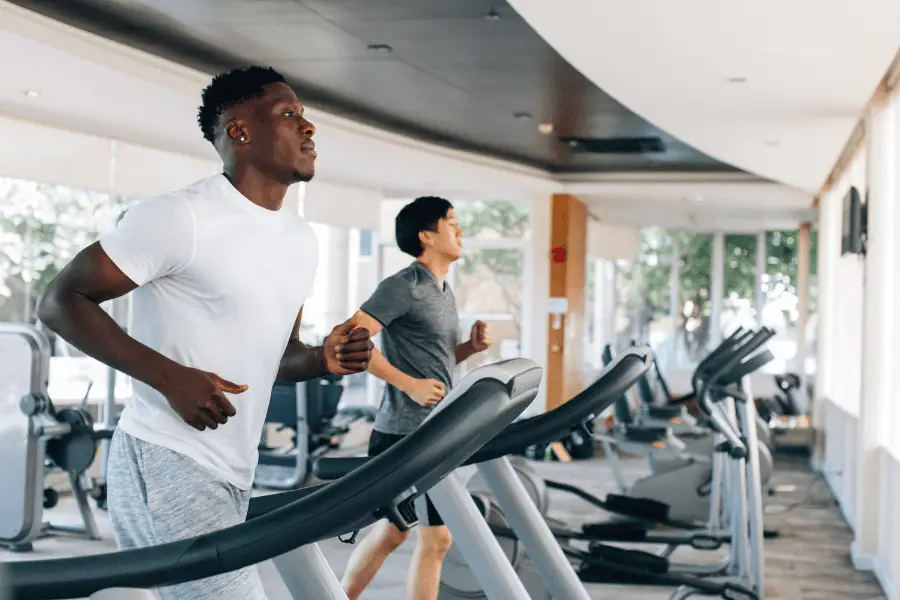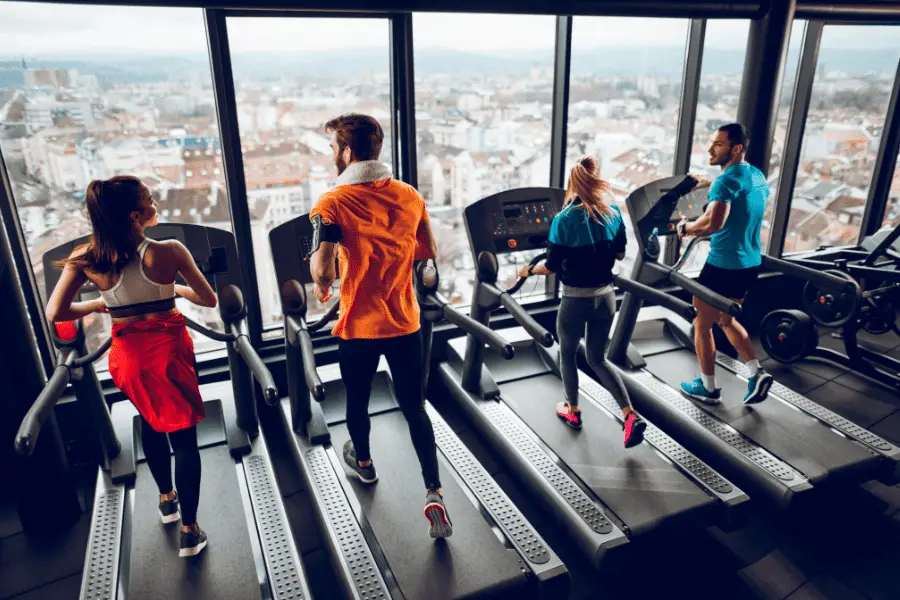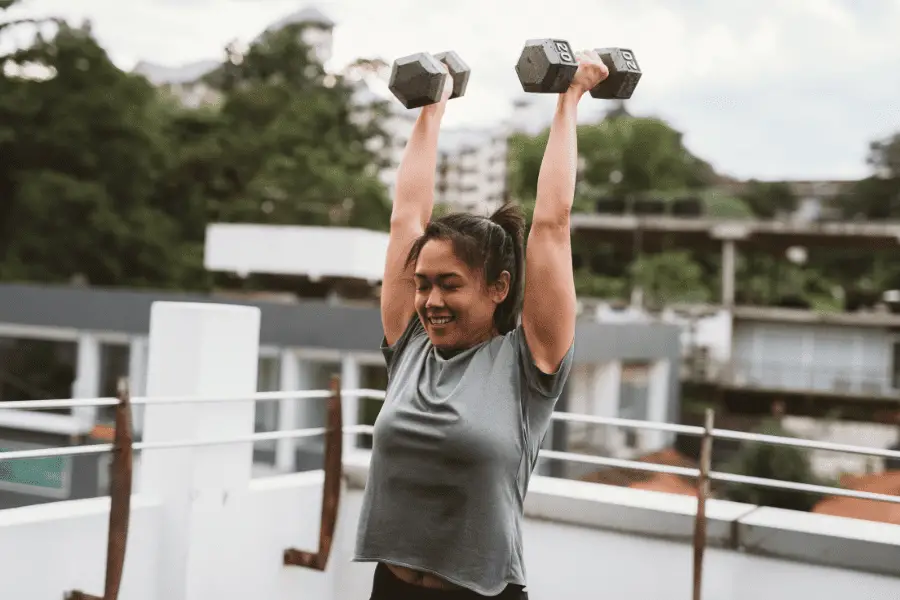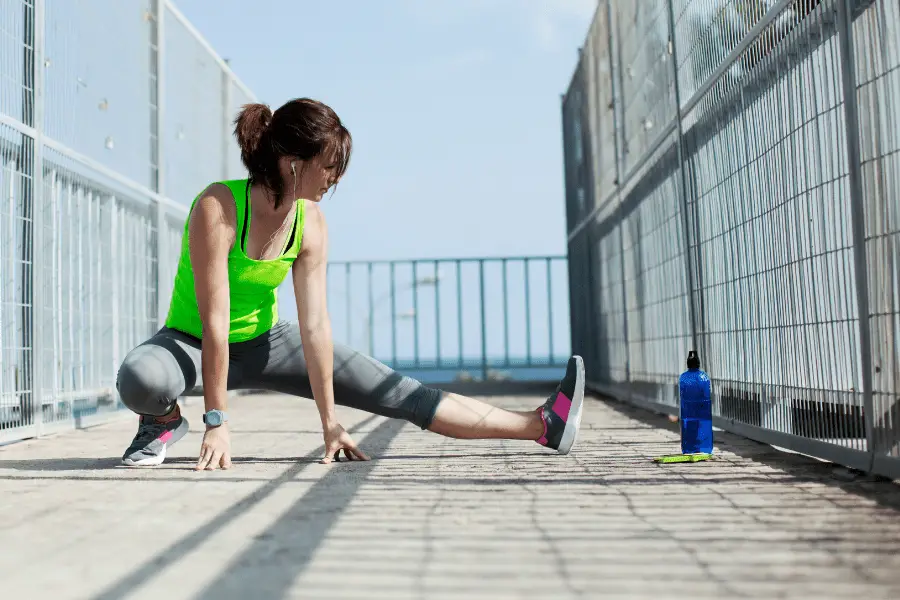The treadmill is the most popular cardio machine at home or in any gym in the world. But how long do you have to work out on one? Is 45 minutes a day enough to see weight loss and/or health improvements? Here’s what you want to know.
Using a treadmill at moderate intensity for 45 minutes can burn an average of 432 calories (weight and speed dependent). This is enough to see good weight loss (if diet is in order), endurance, health and strength benefits.
What can you expect from 45 minutes on a treadmill? And what can you do to make the most of your workouts? Find out below.
Contents
What Does 45 Minutes On a Treadmill Do?
45 minutes on a treadmill is a good amount of exercise. At moderate intensity, running on a treadmill will burn around 432 calories. At high intensity it’ll be more but running for 45 minutes at high intensity is probably not realistic for most people. Moderate intensity is what most people work out at especially if you’re doing more than 30 minutes.
This is enough to notice pretty significant weight loss provided your diet is in order. A pound of fat contains about 3500 calories worth of energy. That means 432 calories will burn off a pound in about 8 workouts. Again, that is provided you eat the right amount of calories.
For health and performance, 45 minutes of running is a great target for most people, especially if you’ve got a sedentary job. 30 minutes a day/5 days a week of moderate exercise is the minimum recommended amount of exercise for heart health. And that’s on top of your normal movements during the day. Those 30 minutes already assume you take at least a couple thousand steps a day. Most people don’t get those few thousand steps so 45 minutes of exercise compensates for this.

If you aren’t capable of doing 45 minutes on the treadmill at the moment, see if you can decrease the speed and/or incline on the treadmill. For most goals, it’s better to do more minutes at a slower speed than the max speed you can handle for 10 minutes. Wear a heart rate monitor to make sure you pace yourself. Staying within the right heart rate range will help you optimize the duration and calorie burning.
What if you’ve only got 15 minutes to spare? Here’s what kind of results you can expect.
How Do Treadmills Burn Calories?
The more you weigh the more calories you will burn during an exercise. There are two important factors in weight: Muscle mass and body fat. The greater your muscle mass, the quicker you will burn calories. This is because more muscle can burn more calories just like a bigger engine burns more fuel in a car. However, if you are heavier because of higher body fat, you’ll also burn more calories because you’re moving more weight around.
One thing that doesn’t depend on your weight is the length and intensity of your workout. The longer your workout and the higher intensity, the more calories you will burn. You can increase the intensity of your workout by running at a higher speed, increasing the resistance, and using High Intensity Interval Training (HIIT)
High Intensity Interval Training (HIIT) Is a great way to burn more calories in a short period of time. A good interval timer is going to make HIIT workouts much more enjoyable.Check out the GymNext Flex timer. It’s super easy to set up and control contrary to most other interval timers making the set up for any workout a breeze.
However, not everyone is in a position to do very high intensity workout and use HIIT. In that case you can get the same weight loss results as a high-intensity workout by doing a low-intensity workout for a longer amount of time. As long as you are continuously moving, you will burn calories. In that way, you can keep going at any speed with any resistance level that you want until you have burned the number of calories you desire. However, to burn a meaningful amount of calories will take more than 30 minutes.
In the end, your muscles moving your legs and your heart pumping all the blood and nutrients around is what burns calories. The harder it is for your muscles and heart, the more calories you burn. But that intensity can be replaced by a lower intensity for a longer duration.
If you have a built in calorie counter on your treadmill depends on the type and how fancy it is. That said, most new treadmills have a calorie counter and even heart rate monitor built in. Don’t forget to set your weight if possible: That makes the counter a lot more accurate.
The question is if you can see results by using a treadmill for 45 minutes a day. You burn more calories in a certain amount of time if the average intensity in that time is higher. So if you run as fast as you can for 45 minutes on the treadmill, you’ll see more results than if you walk at a leisurely pace for the same 45 minutes. However, it also depends on your diet but more on that later.
A 155 lbs. person running at 5 MPH burns 288 calories per 30 minutes. That same person running at 6 MPH burns 360 calories per 30 minutes. That means about 432 calories per 45 minutes @5MPH. Since a pound of fat has about 3500 calories. If you eat exactly enough calories to maintain weight without exercise, doing 45 minutes on a treadmill means you lose a pound of fat in about 8 workouts.
How Often Should You Use A Treadmill?
You can run on a treadmill every day if you want and you recover quick enough. Adults are recommended to get at least 150 minutes of medium intensity to vigorous exercise a week. Typically, people reach this by working out for 30 minutes a day, five days a week. This way you allow the body time to rest and recharge.
Exercising at least 150 minutes a week is recommended for preventing weight gain and general health. If you are looking to increase weight loss, however, you should be striving for around 250 minutes of exercising a week (while maintaining a healthy diet, of course). In that case, it is recommended to work out 45 minutes to an hour for five days a week.

Keep in mind, those 30 minutes recommendations assume that you have a moderately active lifestyle outside of exercise. That means at least a few thousand steps a day. If you don’t get to a few thousand steps a day outside of exercise, getting up to 45 minutes a day is better.
There is nothing wrong with using a treadmill more than five days a week, as long as you are not doing long high-intensity sessions each day. If you want to run every day without breaks, it’s better to do longer but low intensity workouts. However, rest days are always a good idea. Your body might not start complaining the first few weeks but if you keep up the schedule for a long period of time, you probably get some weird aches and pains that could have been prevented by taking time off.
Combining cardio exercise with resistance training will make your workouts even more effective. Varying your workouts makes them less repetitive and building some muscle raises your resting calorie expenditure which means you burn more calories while sleeping! Stronger and bigger muscles also make you look better and compound the physique improvements you get from fat loss.
Can you get abs just from running on a treadmill? Find out here.
What Areas of The Body Do Treadmills Target?
Treadmills use certain body parts more than others. However, that doesn’t mean you can use it to spot reduce fat in the used areas. A treadmill uses your hamstrings and glutes but that doesn’t mean your body will strip the fat of those body parts, fat loss doesn’t work that way. Burning calories will lower your overall body fat percentage but where that fat is removed depends on factors like: Genetics, age, gender, and hormone balance.
It’s better to think of running on a treadmill to burn calories and therefore lose overall body fat while improving cardiovascular health and strengthening your lower body muscles. Consistently running on your treadmill will start removing fat from part of your body.
Suggested: How to turn on your treadmill and use it for the first time
Cardio
Besides burning calories, treadmills are great at improving cardiovascular health. Running on a treadmill is very similar to running outside but there are some differences. However, from a cardiovascular perspective, they are very similar.
Aerobic exercise makes your heart and lungs work harder to get blood and oxygen to your muscles. This is the process that is strengthening your cardiovascular endurance while using a treadmill.
Regular cardiovascular exercise also has benefits for mental health, digestion, calorie partitioning and many more processes in your body.
Suggested: How much does a treadmill for a home gym cost?

Lower Body
Treadmills don’t use the upper body in a meaningful way. Sure, running is a full body workout and you move parts of your upper body but they don’t get activated to a large degree. Especially not if you compare it to lower body activation.
Treadmills mainly target the lower body. Good treadmills have the option to change incline settings to target different leg muscles, namely your glutes, hip flexors, quadriceps, hamstrings, and calves.
Suggested: Can you walk on a treadmill without shoes?
Running or walking on a flat treadmill will target the quadriceps more. The more you increase the incline, the more the focus pivots to the rear of the legs. So that means the higher the incline the more focus on glutes, hamstrings and calves.
Also, increasing the incline dramatically increases the amount of calories you burn because the intensity is much higher. Just like running outside on flat ground is much easier than running up a hill.
Unlike elliptical trainers, exercise bikes or rowing machines, running on a treadmill means your feet impact the belt continuously. This can cause your joints and spine to start aching and your recovery time to be longer. Getting a high quality treadmill with good damping in the belt will dramatically reduce the impact on every stride which means you recover quicker and can work out more often. In the long run (pun intended) this means you’ll see much better results with less injury risk.
Core
With every stride, your body naturally contracts your abs and other core muscles to keep you balanced and to keep a straight posture. This will strengthen the core. The faster you run, the higher the core activation tends to be. If you’re untrained, you’ll get some core strengthening effects from running. However, if you’re more advanced, just running isn’t going to be enough if you want to strengthen the core.
Running doesn’t activate and train the complete core either. And since it’s necessary to have a strong core for high intensity exercise, it’s a good idea to do some separate core strengthening exercises besides running. Some simple bodyweight exercises can dramatically increase core strength in a few weeks if done regularly.
Are you looking for visible abs? Running on a treadmill still plays a big role. That’s because having visible abs requires the right combination of the ab muscles being big enough and having a low enough body fat percentage. A treadmill is a very useful tool to reduce body fat percentage. To really make your abs pop, it’s a good idea to do more ab exercises apart from running.
What Can You Do To Make Your Treadmill Time More Effective?

Nutrition
The key to optimizing the results of your workouts, whether it’s running, cycling, weightlifting or any other activity, is to eat balanced and nutritious meals. To get the most out of your physical activity, you have to be giving your body sufficient energy to perform. Some forms of energy are better than others. Paying attention to total calories, macronutrients and micronutrients are all important to giving your body the best fuel.
Now, what is considered to be a balanced diet depends on what you are trying to accomplish. There will be a different amount of calories you should be consuming a day and a slightly different ratio of carbohydrates, fats, and protein (macronutrients).
Cook your own meals and try to avoid processed foods as much as possible. A good target to shoot for is to get 80% of your calories from whole foods. It’s very tough to eat 100% whole foods and shooting for 80% is more likely to give you enough leeway to be able to stick to it.
Typically, your ratio of macronutrients should be:
- 30–35% of your calories from protein
- 40–50% of your calories from carbs
- 10–30% of your calories from fat
(Source)
There are a lot of different ideas about what the optimal ratios of macronutrients are but basically, you want to get enough protein (0.6-0.8 grams per pound of bodyweight) and enough healthy fats (up to 30% of total calories) and fill the rest of your calorie needs with carbs.
To lose weight, you need to be taking in fewer calories than you are going to burn from exercising. Using a calorie tracker and calculating your Base Metabolic Rate (BMR) are useful tools do discover how many calories you take in and use during a day.
A kilo of fat has 7700 calories. So by consuming 550 calories fewer per day than you use, you’ll burn through a kilo of fat every two weeks. Running or other cardio exercise helps increase the amount of calories you burn on a day (about 300 per 30 minutes). That means if you eat 250 calories less than you need and burn 300 more calories through working out you have a deficit of 500 calories.
So after eating right and running for 30 minutes 5-6 days a week, you’ll lose about 2-3 kilos (4.4 – 6.6 lbs.) after 4-6 weeks. For most people this won’t be enough to reach their goal but it will be visible. After 8-10 weeks your weight loss would be about 4-5 kilo (8.8-11 lbs.)
It’s not a good idea to create a bigger calorie deficit than about 500 calories per day unless advised by a healthcare professional. Larger calorie deficits are more difficult to sustain for long periods of time and make it more likely you won’t have the willpower to keep going.
A note about protein: It is a myth that you need to consume significant amounts of protein to gain muscle. Strength training is how you will build muscle! Yes, your body needs protein to repair and grow the muscles but, if you consume more protein than your body needs in a day, it will be converted and stored if it exceeds your daily calorie needs. Thus, eating so much extra protein you go over your daily calorie goal, will actually go against your goal and reduce the efficiency of your workout. About 0.6 – 0.8 grams per pound of bodyweight is a good goal.
Strength Training Exercises
As you can read above, running mainly strengthens the muscles in the lower body. To strengthen other muscle groups or focus on some specific ones, you use strength training. Combining the calorie burning and cardiovascular benefits of running on a treadmill with strength training is very effective and will multiply the effect you would get if you’re only doing one of the two. Lowering body fat and increasing muscle mass is a winning combination to improve your physique.
The best way to include strength training exercises in your running workouts is to do them after. That’s if you want to focus on weight loss. If you want to focus on muscle building, it’s better to do the strength exercises first. It’s also possible to do some dumbbell exercises while running for a more interesting workout.
It’s best to do a full body strength workout that targets all body parts. If you don’t want to do all the body parts on one day, you can split them up as well. It’s best to hit all the body parts twice a week. Training your whole body creates a better overall physique and prevents major muscle imbalances. It also means you create more real world strength that’s useful in daily life.

Stretching Before And After
Before and after any workout it is a good idea to stretch. If you begin working out without warming your muscles, you are more likely to injure yourself during your exercise. Stretching is a light way to warm up your muscles and prepare them to be used.
Good pre-workout stretches include:
- The Pike Stretch– Start by standing with your legs shoulder-width apart and reach down to put your hands in front of your toes. You’ll then slowly walk your hands forward while keeping them shoulder-width apart and keeping your legs straight. Essentially, you are walking yourself into the yoga stretch “downward dog.” Stay in that position for 30 seconds. This will stretch your hamstrings and calves.
- Trunk Rotations– Start lying on your back with your hips and knees bent and your feet flat on the floor. Your arms should lay straight at your sides. Squeeze your shoulder blades and flatten your neck to the floor while rotating your legs to the left. As you twist, your right shoulder blade and arm should remain flat on the floor. Hold that position for a few minutes and then slowly return to the starting position and rotate your legs to the right side. This will stretch your shoulders, legs, and core.
- Lunges– Lunges are an example of dynamic stretching, a way to stretch by constantly moving as opposed to holding a pose for a long amount of time. Since lunges target the leg muscles and back, doing a set or two of them before getting on the treadmill can help get the blood flowing through your legs and prepare them for endurance.

Good post-workout stretches include:
- Chest Stretch– Start by standing with your feet slightly wider than shoulder-width. Place your hands on the back of your head with your arms raised and elbows pointed to the sides. Bring your shoulder blades together as you press your elbows backward.
- Seated Glute Stretch– Start by sitting in a chair with one foot flat on the floor. Place your other leg so that its ankle is over the knee of the foot flat on the floor. Slowly bend forward while keeping your back straight until you feel a slight pull in your hips and glute muscles. Hold that position for 30-60 seconds and repeat with the other leg.
- Cat-Cow Stretch- Start with your hands and knees on the floor, with your spine straight and relaxed. As you inhale, press your chest forward as if making your back into a bowl. As you exhale, relax your shoulders and round your spine upward, and press your hips forward as if making your back into a hill. Relax your shoulders and continue to go between these positions for a minute.

